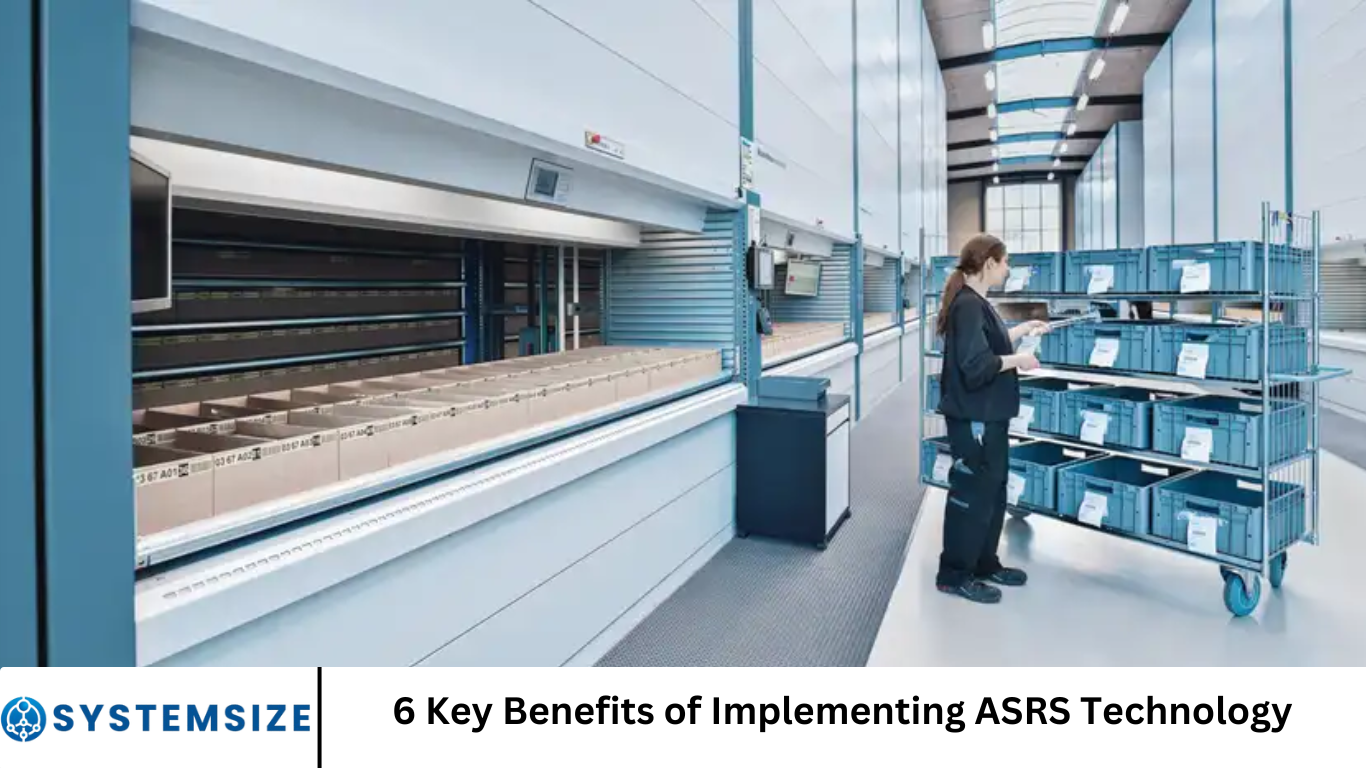Competitive and rapidly evolving supply chain environment, companies are constantly looking for ways to optimize operations, reduce costs, and improve overall efficiency. One of the most effective technologies aiding this transformation is Automated Storage and Retrieval Systems (ASRS).
Whether you’re operating a warehouse, distribution center, or manufacturing facility, ASRS technology can revolutionize the way you handle materials and manage inventory. In this article, we delve into the six key benefits of implementing ASRS technology, and why this automation solution is increasingly essential for modern operations.
More Read: 10 Key Warehouse Storage Metrics for Efficient Resource Management
1. Maximized Space Utilization
One of the most immediate and visible advantages of ASRS is its ability to optimize warehouse space. Traditional racking and shelving systems require wide aisles and horizontal expansion to accommodate inventory. In contrast, ASRS systems utilize vertical space, allowing businesses to store more items within a smaller footprint.
How ASRS Maximizes Space:
- Vertical Storage: Systems like vertical lift modules (VLMs) and vertical carousels capitalize on unused overhead space.
- High-Density Storage: Goods are stored compactly and retrieved with robotic precision, eliminating wasted space.
- Reduced Aisle Requirements: Automation minimizes the need for wide aisles required by forklifts and manual pickers.
This efficient use of space can help defer the need for warehouse expansion or even allow you to downsize your current footprint, saving on real estate costs.
2. Enhanced Picking Accuracy
Manual picking processes are prone to human error, leading to costly mistakes, customer dissatisfaction, and inefficient returns management. ASRS improves picking accuracy dramatically through automation and integrated guidance systems.
Accuracy-Enhancing Features:
- Pick-to-Light and Pick-to-Voice Technologies: These guide operators to the correct items.
- Barcode Scanning Integration: Ensures correct items are picked every time.
- Error Reduction Algorithms: ASRS systems often include software that flags inconsistencies or potential errors in real-time.
Improved accuracy directly translates to higher customer satisfaction, fewer returns, and enhanced reputation.
3. Faster Throughput and Operational Efficiency
ASRS is designed to speed up the storage and retrieval process, which in turn increases order fulfillment speed. This is particularly critical in e-commerce and just-in-time (JIT) manufacturing environments.
Throughput Improvements:
- Reduced Travel Time: The system brings items to the picker, eliminating long walks and search time.
- Simultaneous Picking: Some ASRS models allow multiple orders to be picked at once.
- Optimized Inventory Access: Real-time data ensures the fastest possible access to stored items.
With faster throughput, companies can handle more orders in less time, meeting increasing customer expectations for same-day or next-day delivery.
4. Improved Labor Productivity and Cost Savings
Labor accounts for a significant portion of operational expenses in any warehouse or distribution center. ASRS automates many manual tasks, reducing the need for large labor forces and increasing the productivity of remaining staff.
Productivity Gains:
- Fewer Workers Needed: A smaller team can handle larger volumes.
- Reduced Training Time: Intuitive interfaces and automation reduce the learning curve.
- Minimized Downtime: Automated systems can operate with minimal breaks, increasing uptime.
Cost Savings:
- Lower Labor Costs: Fewer employees needed for picking and replenishment.
- Reduced Errors: Less money spent on correcting mistakes.
- Energy Efficiency: Many ASRS units are designed with sustainability in mind, consuming less power than traditional systems.
5. Real-Time Inventory Management and Visibility
Maintaining accurate inventory levels is crucial for effective supply chain management. ASRS integrates seamlessly with Warehouse Management Systems (WMS) to provide real-time visibility into stock levels, locations, and movements.
Inventory Management Advantages:
- Automatic Inventory Tracking: Updates stock levels as items are picked or stored.
- Cycle Counting Integration: Enables ongoing, real-time cycle counting instead of disruptive annual counts.
- Better Demand Forecasting: Accurate data improves planning and reduces stockouts or overstock situations.
Improved visibility ensures you can make data-driven decisions that enhance overall efficiency and customer satisfaction.
6. Enhanced Workplace Safety and Ergonomics
Warehousing and manufacturing environments pose various physical risks, especially when manual lifting, bending, and climbing are involved. ASRS dramatically reduces these risks by delivering items directly to operators at an ergonomic height.
Safety and Ergonomic Benefits:
- Eliminates Need for Ladders and Lifting: Reduces risk of falls and strain injuries.
- Adjustable Workstations: Many systems offer height-adjustable picking bays.
- Reduced Repetitive Strain: Less walking, reaching, and manual handling.
Creating a safer work environment not only protects employees but also reduces workers’ compensation claims and improves employee morale and retention.
Bonus: Scalability and Integration Capabilities
While we’ve outlined six key benefits, it’s worth noting that ASRS systems are also highly scalable and integrable. Whether you’re a small operation or a large enterprise, ASRS can grow with your needs and integrate with robotics, conveyors, and software platforms.
Scalability Features:
- Modular Design: Add or reconfigure units as needs evolve.
- Software Integration: Seamless compatibility with ERP and WMS systems.
- Flexible Applications: Suitable for multiple industries including retail, automotive, pharma, and electronics.
Frequently Asked Question
What is an Automated Storage and Retrieval System (ASRS)?
An ASRS is a type of warehouse automation technology that uses robotics, conveyors, and software to automatically store and retrieve goods from specific locations. These systems optimize space, improve accuracy, and increase picking efficiency.
How does ASRS improve warehouse space utilization?
ASRS units are designed to use vertical space, reducing the need for wide aisles and maximizing storage density. This allows businesses to store more items in a smaller footprint, often eliminating the need for warehouse expansion.
What types of ASRS systems are available?
Common ASRS types include vertical lift modules (VLMs), vertical and horizontal carousels, mini-load and unit-load systems, and robotic shuttle systems. Each is suited to different types of inventory, throughput needs, and warehouse layouts.
Is ASRS suitable for small and medium-sized businesses (SMBs)?
Yes, modern ASRS solutions are scalable and modular, making them accessible for SMBs. Smaller systems can be implemented affordably and expanded over time as business needs grow.
How does ASRS impact labor requirements and costs?
ASRS reduces the need for manual labor by automating repetitive and time-consuming tasks. This leads to lower labor costs, fewer picking errors, and improved employee productivity and safety.
Can ASRS integrate with existing warehouse management systems (WMS)?
Absolutely. Most ASRS solutions are designed to integrate seamlessly with existing WMS, ERP, and inventory management software, providing real-time data and improved operational visibility.
What is the typical ROI timeline for ASRS investments?
The return on investment (ROI) for ASRS systems varies depending on the scale and application, but many businesses report a full ROI within 18 to 36 months due to savings on labor, improved accuracy, and space efficiency.
Conclusion
Implementing ASRS technology offers a transformative opportunity to modernize your material handling processes. With benefits ranging from maximized space utilization to enhanced safety and improved productivity, ASRS positions your operation for future growth and resilience. As customer expectations rise and supply chain complexity increases, investing in automation is no longer optional—it’s a strategic imperative. Whether you’re beginning your automation journey or looking to expand existing systems, ASRS can deliver measurable ROI, improved accuracy, and long-term operational success.


